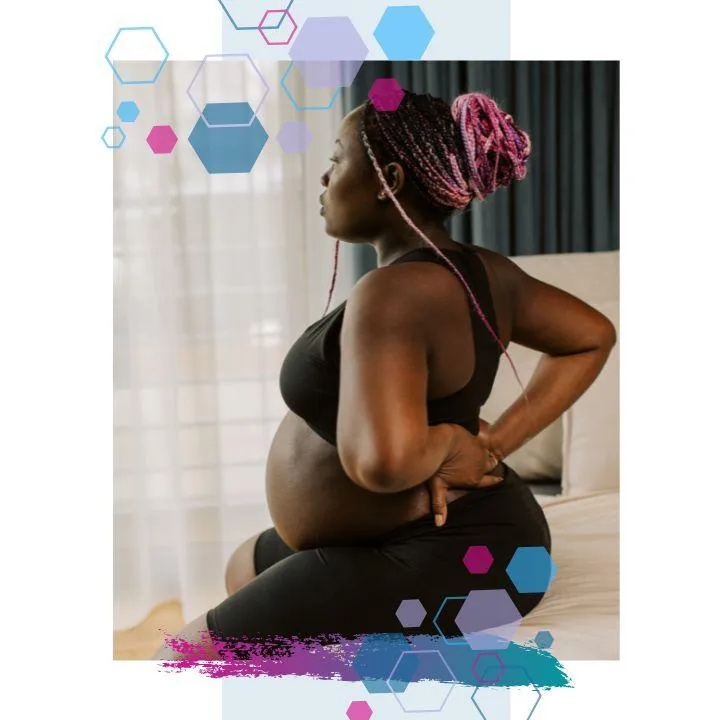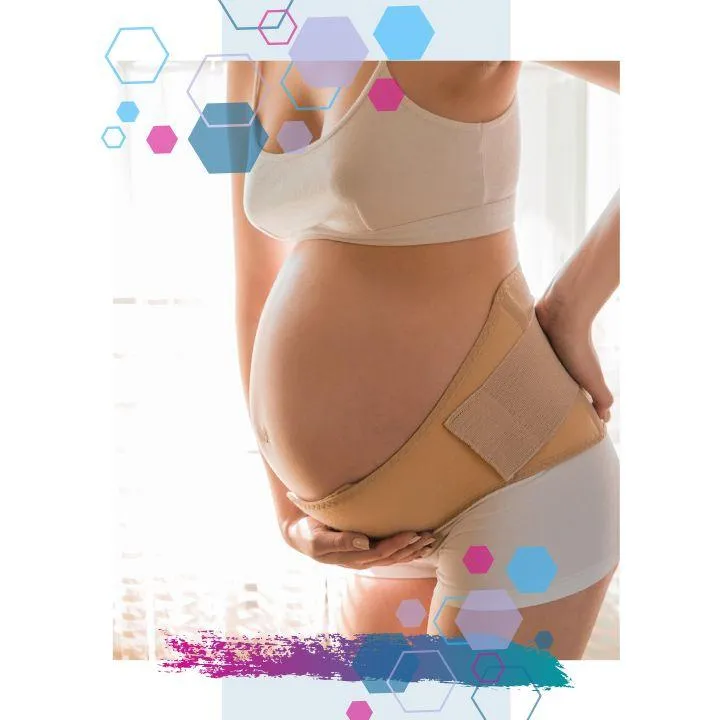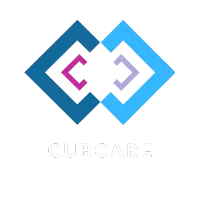We're an award winning Antenatal and Postnatal Education Platform 2025!
(read more here)
Pregnancy & Birth with Hypermobility:
The online HSD/hEDS Informed Antenatal Course
The antenatal course built for people with HSD or hEDS — where pelvic pain, fast labours, and dysautonomia aren’t surprises, they’re planned for.
You’re the one asking the questions no one else seems to have answers to.
“What if labour moves too fast?”
“Why does everything hurt more than it should?”
“Is anyone actually going to take this seriously?”
This course is built for people with HSD or hEDS — people whose bodies don’t fit the standard template, and who are done being told to “wait and see” or “I'm sure it'll be fine.”
Inside, we make space for what hypermobility actually means in pregnancy and birth — from pelvic pain and dysautonomia to fast labours, positioning, pacing, and postnatal healing. You’ll learn how to protect your energy, move in ways that support your joints and your labour, and get clear on what to expect when your body moves differently.
You’ll find evidence-based strategies that reflect your reality — not worst-case scenarios and statistics, not rigid birth plans, but tools that work with your connective tissue, not against it.
Whether you’re preparing for your first birth or trying to avoid what happened last time — this is the support you should have had from the start.
You’re in the right place if:
• You’re planning for birth with Hypermobility Spectrum Disorder (HSD) or hypermobile Ehlers-Danlos Syndrome (hEDS) and want more than generic advice
• You want to understand how hypermobility might affect pregnancy, labour, recovery, and everything in between — and what to do about it
• You’ve been told your symptoms are “just part of pregnancy” — but your body says otherwise

It starts with knowing your body is different — and needing to know why that matters.
Maybe pregnancy has felt harder than you expected — more pain, more fatigue, more uncertainty.
Maybe things don’t add up. The way your hips ache. The way movement feels off. The way your heart races when doing simple every day things.
The way no one seems to explain what’s happening in a way that fits you.
This course helps you understand how Hypermobility Spectrum Disorder (HSD) or hypermobile Ehlers-Danlos Syndrome (hEDS) can shape your experience of pregnancy, labour and recovery.
We don't just talk through risk — we go deep into the real differences in how your body moves, adapts and responds.
Because when you understand those differences, everything changes.
Suddenly, faster labours make more sense and something to positively prepare for. Certain positions become more supportive. Your body becomes something to work with, not worry about.
Hypermobility can come with challenges — but it also brings space, stretch, and a kind of adaptability that can make birth smoother, when you’re prepared for it.
You don’t want to just put up with symptoms or hope your care team connects the dots.
You want to understand what’s happening in your body — and how to work with it before it catches you off guard.
When you live with Hypermobility Spectrum Disorder (HSD) or hypermobile Ehlers-Danlos Syndrome (hEDS), the usual advice often misses the mark.
You might move differently. Fatigue might hit harder. Labour might speed up without warning. Recovery might feel like it’s taking longer than anyone says it should.
And none of that means you’re broken.
It means you need a different kind of preparation — one that helps you move in ways that protect your joints, make space for your baby, and reduce unnecessary interventions. One that helps you recognise what’s normal for your body, and how to ask for what you need when standard care doesn’t quite fit.
Because it’s not just about getting through labour.
It’s about understanding how your body behaves under pressure — so you can stay present, supported, and in charge of your experience.
This is about planning for what’s most likely — not just what might go wrong.
And giving yourself the best chance of a smoother birth and a steadier recovery.

That's why I am so excited to welcome you to...
Pregnancy & Birth with Hypermobility: The HSD/hEDS Informed Antenatal Course
This course gives you insight, tools and preparation — right from early pregnancy — so you’re not left figuring it out when symptoms escalate, labour speeds up, or recovery feels tougher than expected.
You’ll understand how hypermobility affects birth physiology, how to adapt common techniques for your joints and nervous system, and how to prepare for scenarios that aren’t always covered in standard antenatal care.
We explore everything from pelvic stability and positioning, to dysautonomia management, pacing, and postnatal healing.
You’ll also get strategies for communicating with healthcare professionals, recognising when something isn’t just “normal”, and navigating decision points with confidence.
This is straight-talking, evidence-based antenatal education — designed for people whose bodies move differently, and who deserve support that actually reflects that.

What’s covered in the Pregnancy & Birth with Hypermobility course?
This online, on-demand course is designed specifically for people with HSD or hEDS who want to prepare for pregnancy, birth and recovery with real insight — not guesswork.
You’ll get clear, evidence-based guidance on what hypermobility means for your joints, muscles, nervous system and labour patterns — and how to plan ahead with practical tools that actually work for your body.
Taught by experienced antenatal educator, doula and hypermobility-aware teacher Jilly Clarke, this course breaks down how to adapt common antenatal techniques to suit your physiology — so you’re not left trying to fit a generic plan to a non-generic body.
Whether you’re navigating pregnancy for the first time, or trying to do things differently after a difficult first birth, you’ll find preparation that reflects what your body needs — and support that helps you move, birth and recover with more understanding.
01
Pregnancy with hypermobility, clearly explained
Understand how HSD and hEDS affect your pregnancy, labour and recovery — and why the usual advice often doesn’t fit.
02
Joint instability and pelvic pain, supported properly
Learn how to reduce discomfort and move more easily in pregnancy with hypermobility — including techniques that protect your pelvis and support daily function.
03
Dysautonomia and fatigue in pregnancy, managed with care
Get calm, practical strategies for pacing, managing blood pressure swings, and supporting your nervous system when dysautonomia flares.
04
What birth looks like with HSD/hEDS
Explore how labour may progress differently in hypermobile bodies — from longer latent phases to faster active stages — and how to adapt confidently when things shift.
05
Positioning and birth biomechanics, adapted for hypermobility
Use your flexibility to your advantage with birth positions that support baby’s engagement and descent — without overstretching or destabilising your joints.
06
Breathwork and core support for pregnancy and postpartum
Build deeper awareness of your breath, fascia and core so you can prepare for labour, reduce injury risk, and support a smoother recovery after birth.
07
Navigating maternity care with hypermobility
Know what to say in appointments, how to advocate when symptoms are invisible, and how to prepare for care that recognises the impact of HSD/hEDS.
08
Postnatal recovery with HSD/hEDS, explained and supported
Understand how hypermobility can affect postnatal healing — including pelvic floor recovery, hormonal shifts, wound healing and emotional wellbeing.
Join now for just £65
Prepare for birth in a hypermobile body with clarity, evidence and real-world support — so you can move, labour and recover with confidence in every step.
What makes the CubCare Hypermobility Course so special?
Most antenatal education isn’t designed for hypermobile bodies — and most practitioners don’t understand what it really means to live with HSD or hEDS.
Created and taught by a doula who lives with HSD/hEDS, it delivers the one thing standard classes can’t: practical, evidence-based guidance shaped by real hypermobile experience.
Know exactly what to expect.
Understand why labour can stall for hours and then race ahead, why certain positions feel wrong, and how to keep things moving without over-stretching or triggering dysautonomia.
Turn flexibility into an advantage.
Use joint mobility and tissue stretch to create space for your baby, shorten active labour, and reduce the chance of avoidable interventions.
Protect your recovery before birth even begins.
Learn the small shifts in movement, breath and pacing that cut post-birth pain, speed wound healing and lower the risk of long-term pelvic issues.
When standard advice stops at “that's normal in pregnancy,” this course shows you why it’s not — and what to do about it.
Because once you understand the mechanics of an HSD/hEDS body in labour, you don’t just hope for a smooth birth — you plan for it.
Client Feedback

My first labour was fast and chaotic, and nobody understood, or particularly cared, why. This time, I knew what signs to look for, how to position myself, and how to speak up in appointments. I still had a fast birth — but I wasn’t shocked. I was ready.
.
Priya - second-time mum with undiagnosed hEDS until after birth one

Every time I tried to explain my pelvic pain or how faint I felt, I got told it was just pregnancy. This was the first time I learned what was actually happening — and how to work with my body, not fight it. I felt more in control going into labour than I ever thought I could."
.
Alex - First time parent with HSD

I started the course not really knowing what was connected to hypermobility — I just knew I felt worse than everyone said I should. This made sense of everything and gave me really clear ways to feel better, move better and stop worrying all the time. I’ve gone from dreading birth to feeling quietly prepared."
Laura - 30 weeks pregnant with hEDS
Hi, I’m Jilly — doula, antenatal educator, and someone with Hypermobility Spectrum Disorder.
I’ve been supporting people through pregnancy and birth since 2014 — but I didn’t create this course because of what I’ve seen in others. I created it because of what I lived through myself.
My first pregnancy and birth were textbook for hypermobility. I had awful hip pain, a racing heart, and constant dizziness. The nausea and sickness were next level and was constantly told it was all just “normal.”
Nobody joined the dots — not even when my long, slow early labour turned into a fast birth that took everyone by surprise.
By my second birth, I knew what to expect — and how to work with my body instead of against it.
It was even quicker, but I felt steady and prepared.
That’s what this course is here to give you:
Real insight. Strategies that fit hypermobile bodies. And support that recognises the reality of pregnancy and birth with HSD or hEDS.
Because your experience matters — and so does how you prepare for it.

FAQs
Can hypermobility affect labour and birth?
Yes — hypermobility can lead to longer early labour, faster active stages, positioning challenges, and increased risk of tearing or pelvic floor dysfunction amongst other things. This course helps you understand why, and how to prepare for smoother, safer labour and recovery.
Will this course help with pregnancy pain from HSD or hEDS?
Absolutely. You'll learn how to move in ways that support unstable joints, reduce pelvic and back pain, and protect connective tissue — all based on the latest evidence and biomechanics-informed practice.
What is the best antenatal course for HSD or hEDS?
This course is specifically designed for people with Hypermobility Spectrum Disorder or hypermobile Ehlers-Danlos Syndrome, offering tailored education you won’t find in standard antenatal classes — including joint protection, dysautonomia support, and birth prep strategies that work with your body.
What should I know about dysautonomia and pregnancy?
Dysautonomia symptoms like dizziness, fainting, and heart rate fluctuations are common with HSD/hEDS. This course explains how pregnancy affects your autonomic system — and how to manage symptoms safely with pacing, positioning, and hydration strategies.
Will I learn how to prepare for birth with joint instability?
Yes — joint instability is a core part of this course. You'll explore how to choose birth positions that support your body, keep labour progressing, and avoid overextension or injury during pushing and recovery.
Is this course suitable for people who haven’t been officially diagnosed?
Yes. Whether you’ve been diagnosed with HSD or hEDS or just suspect your body is hypermobile and isn’t responding like others’ in pregnancy, this course offers insights and support based on real-world experience and clinical knowledge.
Does this course cover postnatal recovery with hypermobility?
It does. We cover wound healing, pelvic floor function, hormonal shifts, pacing, and how to protect your body in the weeks and months after birth — especially if you’ve experienced previous injuries or slow recovery.
How is this course different from standard antenatal classes?
This course is built for bodies that move differently. It goes beyond generic advice to offer hypermobility-specific guidance — blending doula expertise, lived experience of HSD, and practical tools that help you prepare confidently for birth and beyond.
FREE DOWNLOAD
Headline that hooks people in, gets them excited and makes them want to sign up.
Based in Welwyn Hatfield, offering local pregnancy support and doula services across Hertfordshire: St Albans, Hatfield, Welwyn Garden City, Potters Bar, Stevenage, Harpenden, Hitchin, Barnet, Mill Hill and surrounding areas.
Online antenatal and postnatal education available UK-wide.
© Copyright 2025 CubCare The Parenting Hub. CubCare is operated by The Birth and Baby Company Ltd. Company No. 15655287
Privacy Policy | Terms & Conditions | Medical Disclaimer | Inclusivity and Accessibility
